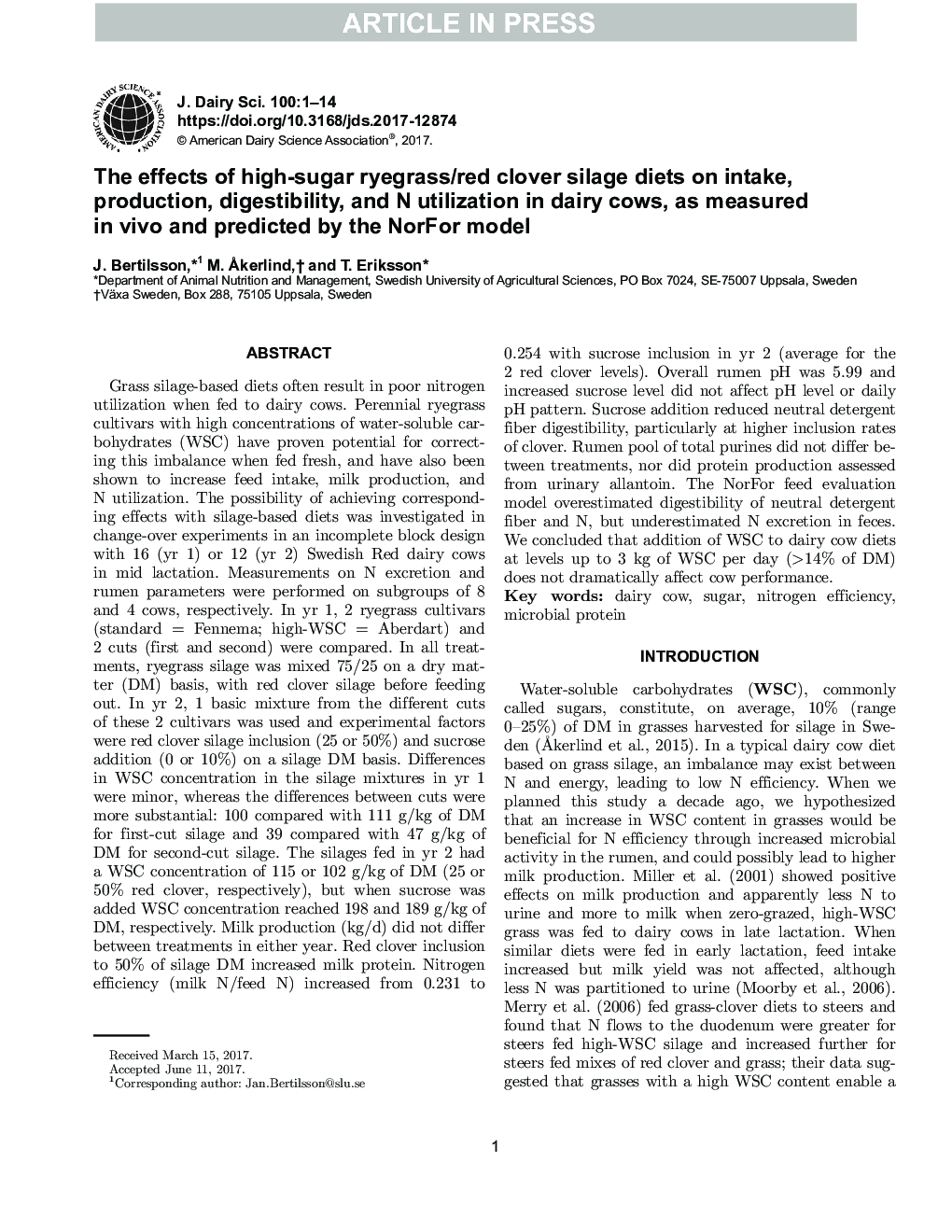| کد مقاله | کد نشریه | سال انتشار | مقاله انگلیسی | نسخه تمام متن |
|---|---|---|---|---|
| 5541989 | 1402513 | 2017 | 14 صفحه PDF | دانلود رایگان |
عنوان انگلیسی مقاله ISI
The effects of high-sugar ryegrass/red clover silage diets on intake, production, digestibility, and N utilization in dairy cows, as measured in vivo and predicted by the NorFor model
دانلود مقاله + سفارش ترجمه
دانلود مقاله ISI انگلیسی
رایگان برای ایرانیان
کلمات کلیدی
موضوعات مرتبط
علوم زیستی و بیوفناوری
علوم کشاورزی و بیولوژیک
علوم دامی و جانورشناسی
پیش نمایش صفحه اول مقاله

چکیده انگلیسی
Grass silage-based diets often result in poor nitrogen utilization when fed to dairy cows. Perennial ryegrass cultivars with high concentrations of water-soluble carbohydrates (WSC) have proven potential for correcting this imbalance when fed fresh, and have also been shown to increase feed intake, milk production, and N utilization. The possibility of achieving corresponding effects with silage-based diets was investigated in change-over experiments in an incomplete block design with 16 (yr 1) or 12 (yr 2) Swedish Red dairy cows in mid lactation. Measurements on N excretion and rumen parameters were performed on subgroups of 8 and 4 cows, respectively. In yr 1, 2 ryegrass cultivars (standard = Fennema; high-WSC = Aberdart) and 2 cuts (first and second) were compared. In all treatments, ryegrass silage was mixed 75/25 on a dry matter (DM) basis, with red clover silage before feeding out. In yr 2, 1 basic mixture from the different cuts of these 2 cultivars was used and experimental factors were red clover silage inclusion (25 or 50%) and sucrose addition (0 or 10%) on a silage DM basis. Differences in WSC concentration in the silage mixtures in yr 1 were minor, whereas the differences between cuts were more substantial: 100 compared with 111 g/kg of DM for first-cut silage and 39 compared with 47 g/kg of DM for second-cut silage. The silages fed in yr 2 had a WSC concentration of 115 or 102 g/kg of DM (25 or 50% red clover, respectively), but when sucrose was added WSC concentration reached 198 and 189 g/kg of DM, respectively. Milk production (kg/d) did not differ between treatments in either year. Red clover inclusion to 50% of silage DM increased milk protein. Nitrogen efficiency (milk N/feed N) increased from 0.231 to 0.254 with sucrose inclusion in yr 2 (average for the 2 red clover levels). Overall rumen pH was 5.99 and increased sucrose level did not affect pH level or daily pH pattern. Sucrose addition reduced neutral detergent fiber digestibility, particularly at higher inclusion rates of clover. Rumen pool of total purines did not differ between treatments, nor did protein production assessed from urinary allantoin. The NorFor feed evaluation model overestimated digestibility of neutral detergent fiber and N, but underestimated N excretion in feces. We concluded that addition of WSC to dairy cow diets at levels up to 3 kg of WSC per day (>14% of DM) does not dramatically affect cow performance.
ناشر
Database: Elsevier - ScienceDirect (ساینس دایرکت)
Journal: Journal of Dairy Science - Volume 100, Issue 10, October 2017, Pages 7990-8003
Journal: Journal of Dairy Science - Volume 100, Issue 10, October 2017, Pages 7990-8003
نویسندگان
J. Bertilsson, M. Ã
kerlind, T. Eriksson,